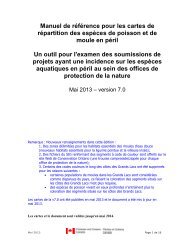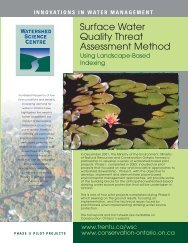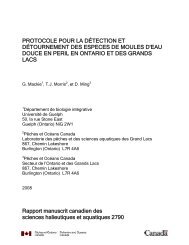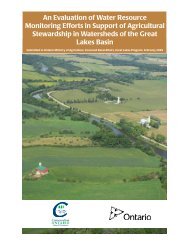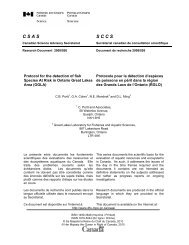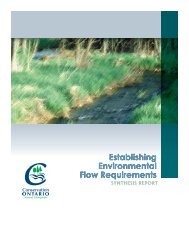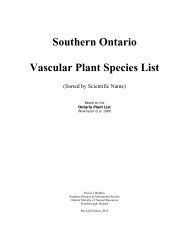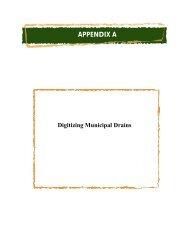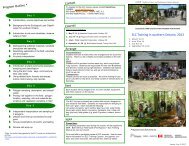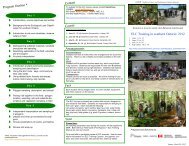Southern Ontario Vascular Plant Species List - Conservation Ontario
Southern Ontario Vascular Plant Species List - Conservation Ontario
Southern Ontario Vascular Plant Species List - Conservation Ontario
You also want an ePaper? Increase the reach of your titles
YUMPU automatically turns print PDFs into web optimized ePapers that Google loves.
PLANTS - http://plants.usda.gov/index.html<br />
VASCAN - http://data.canadensys.net/vascan/search<br />
NatureServe - http://www.natureserve.org/explorer/servlet/NatureServe?init=<strong>Species</strong><br />
<strong>Ontario</strong> Wildflowers - http://www.ontariowildflowers.com/<br />
A full citation for these websites can be found in the References section.<br />
<strong>Species</strong> Code<br />
For data entry in the field it is more efficient to write down (or enter) an abbreviated<br />
code, rather than writing out the entire plant species name. It is much quicker to record<br />
the code APOCANA for Spreading Dogbane, rather than writing out Apocynum<br />
androsaemifolium ssp. androsaemifolium.<br />
Each seven digit code is constructed by using the first four characters of the genus name<br />
followed by the first 3 characters of the species name. Therefore, White Trillium<br />
(Trillium grandiflorum) has the 7 digit code TRILGRA. If there is an additional<br />
subspecies or variety ranking for a species, then the first two characters of the species<br />
epithet are used and the third (last) character consists of the first letter of the subspecies<br />
or varietal epithet. Winged Sumac (Rhus copallinum var. latifolia) has the code<br />
RHUSCOL. All of the abbreviated codes produced for this listing are unique for each<br />
species, subspecies and variety.<br />
In situations where the 7 digit code generated is the same for two separate species, then<br />
an alternate alphabetical character is used for the seventh digit of the code. For example,<br />
Water Arum (Calla palustris) and Spring Water Starwort (Callitriche palustris) would<br />
both produce the same seven character code. In this case the code CALLPLS is used for<br />
Water Arum, and CALLPLU is used for Spring Water Starwort.<br />
Here are some additional examples;<br />
Common Lady Fern Athyrium filix-femina var. angustum ATHYFIA<br />
Slender Loose-flower Sedge Carex gracilescens<br />
CAREGRA<br />
Graceful Sedge Carex gracillima CAREGRM<br />
<strong>Plant</strong>ain-leaf Sedge Carex plantaginea CAREPLA<br />
Broad-leaved Sedge Carex platyphylla CAREPLT<br />
For plants which have had their names changed, the original seven digit code will remain<br />
the same as before, with only the scientific name changing in the plant listing. For<br />
example, Fireweed listed in the previous versions as Epilobium angustifolium, is now<br />
listed as Chamerion angustifolium ssp. circumvagum. The 7 digit code EPILANG will<br />
remain the same, even though this species has been placed into the genus Chamerion.<br />
Often when new varieties are described for an existing species, the resulting code does<br />
not match as it did before. For example Spotted Coralroot (Corallorhiza maculata) had<br />
the code CORAMAC assigned to it. Now that there are two varieties listed for this<br />
species, the original code of CORAMAC is still used for Corallorhiza maculata var.<br />
maculata while Corallorhiza maculata var. occidentalis receives the code CORAMAO.<br />
vi



